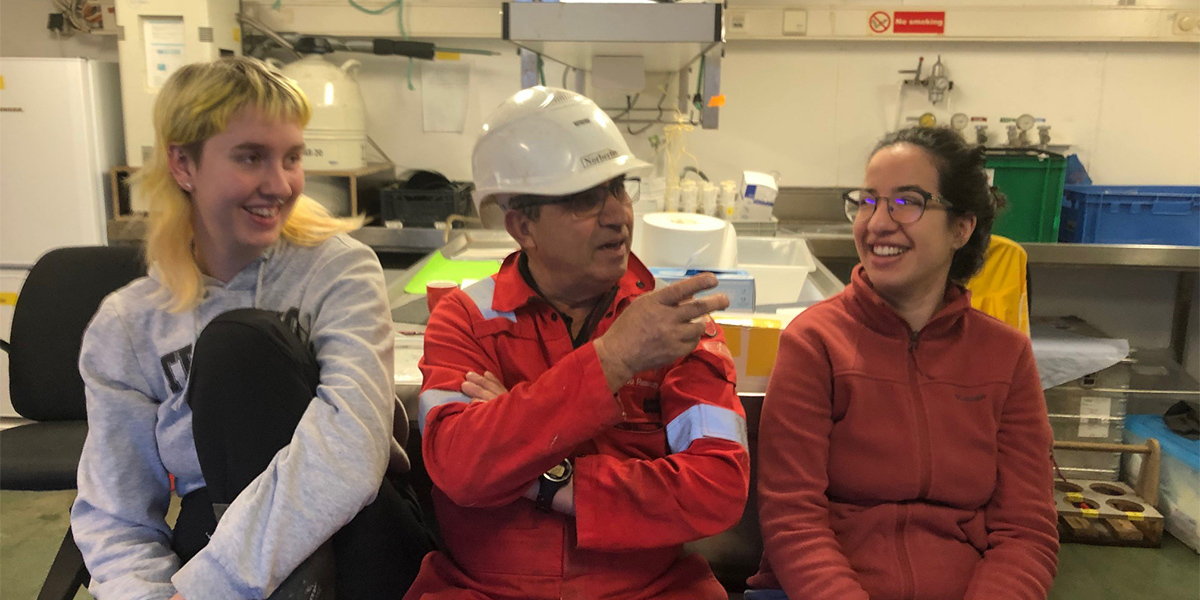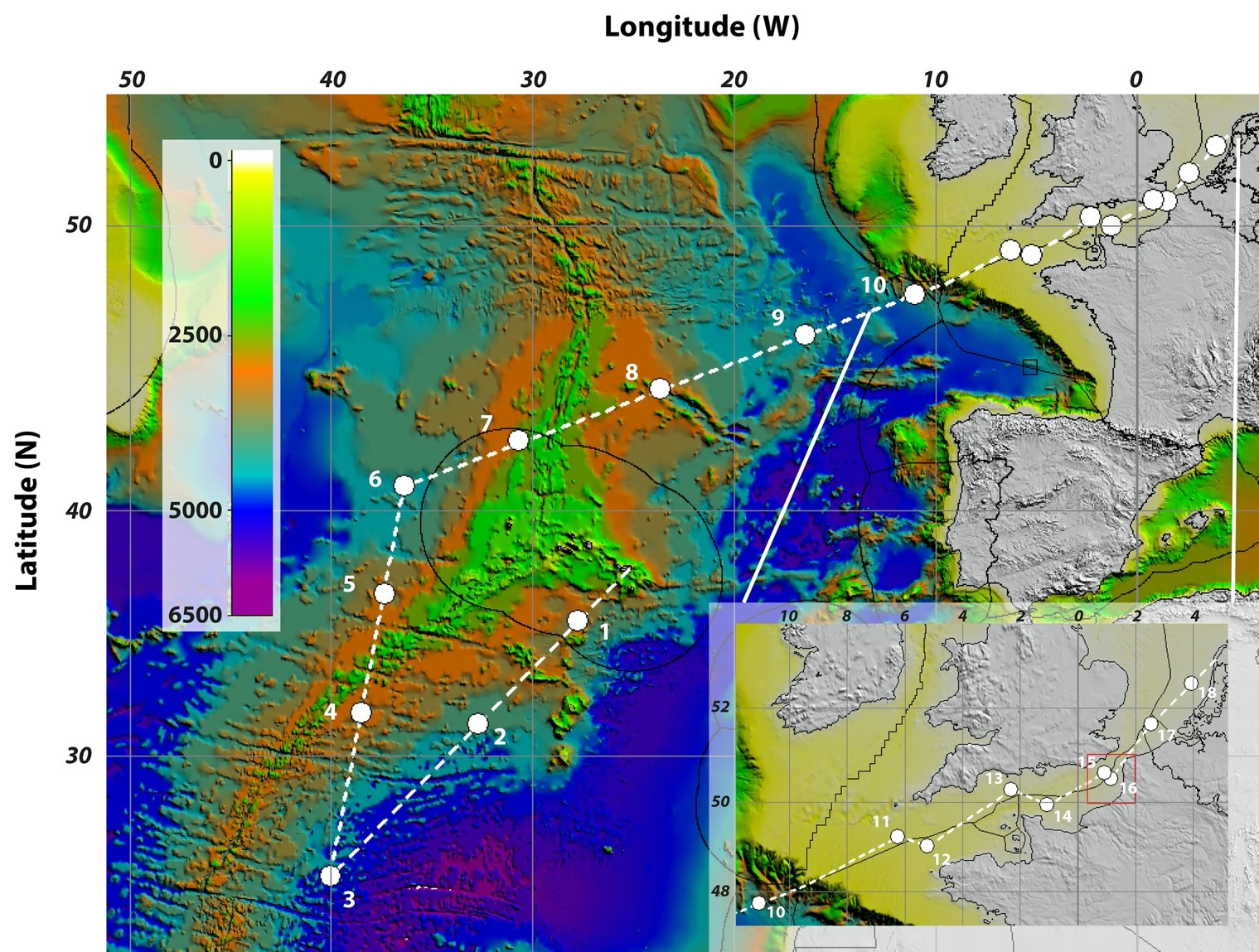
Blog 1: Tuesday 10 November 2020
by Helge Niemann
Five days out at sea on research vessel Pelagia – somewhere in the middle of the Atlantic Ocean, 600 nautical miles SW of the Azores. What are we doing here in mid-November at a time when the world is struck by a global pandemic? We are investigating another global problem, the pollution of our seas with plastic debris.
I am Helge Niemann from the Royal Netherlands institute for Sea Research (NIOZ), professor for Microbial and Isotope Biogeochemistry at Utrecht University, and the chief scientist on this expedition. For the youngest members of the scientific crew, this is their first time out at sea. For me, it is my 27th expedition onboard a research vessel. But the excitement is still the same. My job is to organise this expedition, to determine locations for sampling, to discuss the daily programme with the ship’s crew on the bridge and on deck, to have a plan B ready - in case that weather changes and stormy seas make it impossible to operate heavy equipment. And above all, I try to make sure that all of the different scientists get their samples and can do their measurements.
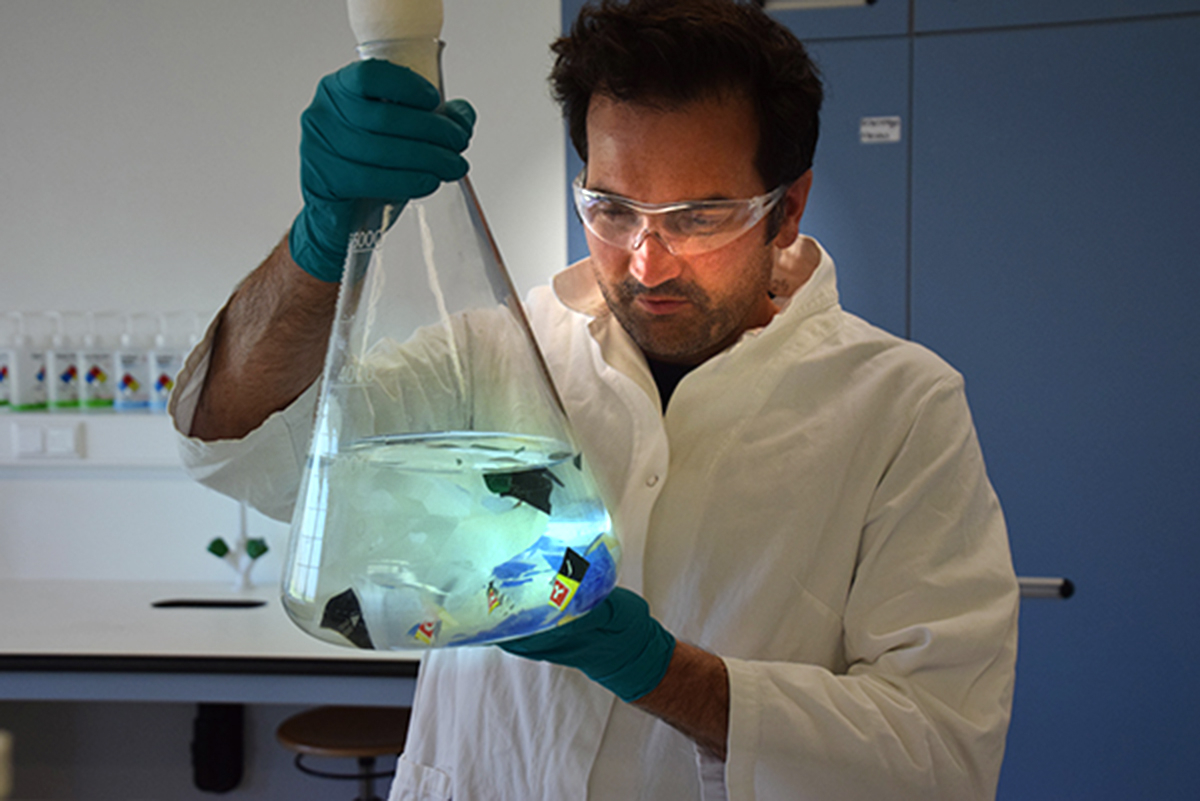
My own interest in this expedition? I study how microorganisms in the ocean can live on unconventional food sources such as greenhouse gasses and plastic. Plastics are difficult to degrade; the long polymer chains make it durable and therefore it stays for a long time in the sea. From an environmental point of view, I hope that the ocean is not only a dead end for plastics, a trash bin that will eventually overflow. From a scientific point of view, I know that microbes are wonderous little critters that can make use of quite exotic compounds. After all, plastics contain a lot of chemical energy, that could, potentially be used by microbes. And indeed, there are some microbes that can degrade certain plastic types. But how fast that happens in the ocean? No one knows… this is one of the questions that my research group investigates. In any case, microbes cannot keep up; every year more plastic is ending up in the ocean. But perhaps in the future, once we have learned to keep our plastic trash away from the sea, maybe then will our leftovers be degraded by microbes.
Right now, I’m staring at the control screen of a water sampler that will bring us samples from the seafloor, 4km beneath us. These samples are eagerly anticipated by the scientists searching in the vast darkness of the deep sea for tiny plastic particles, so-called nanoplastics, and new types of microbes that can degrade these.
The timing is challenging. On the navigation screen, I see our position as a tiny crosshair. It is right in one of the zones where plastics tend to accumulate. But right now, we are sharing that position with the eye of Theta, a subtropical storm that will blow with wind force 8 against us in a few hours. But time is precious: we need to turn north soon to sample other stations. Three weeks lie ahead of us where we will breath ocean science, take samples along our journey of almost 3000 nmi from the subtropical Atlantic to our home shores in the North Sea.
BLOG 2 | 14 November 2020
by Livie Deru
We’re now almost a third of the way through the cruise, still somewhere in the middle of the Atlantic Ocean, and have just finished with another long day of sampling. Although it was an exhilarating experience to sample during a sub-tropical storm, we thankfully made it out the other side to the glorious sunshine, and we’re all hoping that the chief scientist is still considering the BBQ that he’s rumoured to have talked about.
I’m Livie Deru, a bachelor’s student doing an 11-month internship at NIOZ. When I was asked if I’d be interested in participating in this expedition, of course I had to say “yes!” Most people I told about this were quite shocked, as this is my first proper experience at sea, but my excitement definitely outweighed any worries anyone had. My main job on this ship is to assist Emna, a PhD student, in her research on marine fungi and how microbes degrade different types of plastic. However, I do also have my own side project where I’m trying to grow marine Malassezia yeasts in laboratory conditions – something that has never been done before. Using a special medium with a high lipid content, we hope to culture these yeasts and analyse them to see what similarities they share with the terrestrial species and what roles they play in marine systems.
Olivia is looking for a marine fungi (called Malassezia) that has previously been overlooked but could be abundant. For this, she is taking swipes from al sorts of surfaces and trying to cultivate them.
Yesterday was a very exciting day, as we finally got to use the box corer for the first time. This device goes ~3400m down to the seabed to collect sediment that is millions of years old. It was 10pm, and as the crew were draining the core of the excess water, the rest of us were waiting with bated breath, armed with syringes and swabs, to see how much of this deep-sea mud the device had managed to amass. We were making bets on how much there would be, some very optimistic that it would be full, others worried that it would be empty, and that the past two hours of waiting would have all been for nothing. But luckily the latter was not the case! The core was about a third full, which was more than enough for what we needed (I heard that we may have had thousands of euros worth of mud on board with us – if we would have considered to sell it to the beauty industry), and there was plenty left over for us to conserve for various measurements, and all of us kept a small vial of mud as a souvenir.
BLOG 3 | 16 november 2020
In the middle of the Altantic this group of some 50 whales and calves swam alongside RV Pelagia. They probably are short finned pilot whales (grienden) and seemed curious about what was going on. The ship remained more or less at the same position because of the CTD sampling, so the crew and the whales had the change to take a good look at each other.
BLOG 4 | 17 november 2020
by Erik Zettler
Where is the Plastic?
Studies so far cannot locate most of the plastic we know humans have released into the ocean. Part of the goal of the team on board assembled by Helge Niemann is to figure out how much of the “missing” plastic is below the surface suspended in the water column or in the sediments.
I am Erik Zettler and work in the research group of Linda Amaral-Zettler at NIOZ, studying the interactions between microbes and plastic, what we call the “Plastisphere”, with interests that are complementary to those of Helge’s research group.
My main responsibility on this cruise is to collect small pieces of plastic in the water column, below the surface but above the sediments several kilometers under us. To do this we use programmable underwater pumps clamped to a steel cable that our sailor colleagues lower to different depths, from 10m below the surface to just above the bottom of the sea. Each pump is programmed to filter about 1 cubic meter (1000 L) of seawater through different mesh sizes that capture particles from 315 µm down to 2 µm. On board the Pelagia all our work with the filters is done in a special laboratory with filtered air to minimize contamination by airborne plastic. Back on shore the samples will be analyzed carefully to quantify and identify each particle of plastic. Using this information, we can estimate the amount and type of plastic that is suspended in the water column at different depths, and along with information from other sampling equipment, use this to calculate the total amount of plastic along our cruise track.
BLOG 5 | 20 November 2020
By Sophie ten Hietbrink
As I am writing this blog post, we are waiting for the CTD to reach a depth of 3500 metres. Since the instrument descends with 55 metres per minute, it takes some time to reach the water near the bottom. Our current station is still in the open Atlantic Ocean, but in a few days we will enter the gulf of Biscay, approaching the European mainland. Here, closer to the coast, we will be on the continental shelf, meaning that the water depth is only in the order of a few hundred meters at most. Thus we will be able to deploy the CTD more quickly and hopefully, if the weather allows, have some more stations in the English Channel and the Southern part of the North Sea.
I am Sophie ten Hietbrink, and a MSc Climate Physics student from Utrecht University (UU). I hear you asking: What is an UU student doing aboard a NIOZ cruise? Well, I got the amazing opportunity to participate in a collaboration between NIOZ and UU, where I will be studying the distribution of nanoplastics in the water column. Nanoplastic are minuscule plastic particles, smaller than a thousand of a millimeter, that are generated when bigger plastic breaks apart as a result of wave action and sunlight. Nobody knows how much nanoplastic is out there, but it could be an important amount. Research about nanoplastics is relatively new, because we still have difficulties to measure such small particles. This is what I am trying to do in my Master project: to measure nanoplastics in the ocean from the surface to the eternal darkness of the deep sea. To sample sea water from the great depths of the ocean, I use a CTD Rosette. This instrument consists of sensors that measure among other things the temperature, pressure and conductivity of the seawater. Additionally, it incorporates an array of bottles that can be closed at defined depths to capture the desired ocean water. If all goes well, then I will bring back 700 liters of ocean water for analysis at the Institute for Marine and Atmospheric Research Utrecht (IMAU) at UU. I hope that this research will provide a better understanding about what happens with plastic in the ocean and how it is degraded.
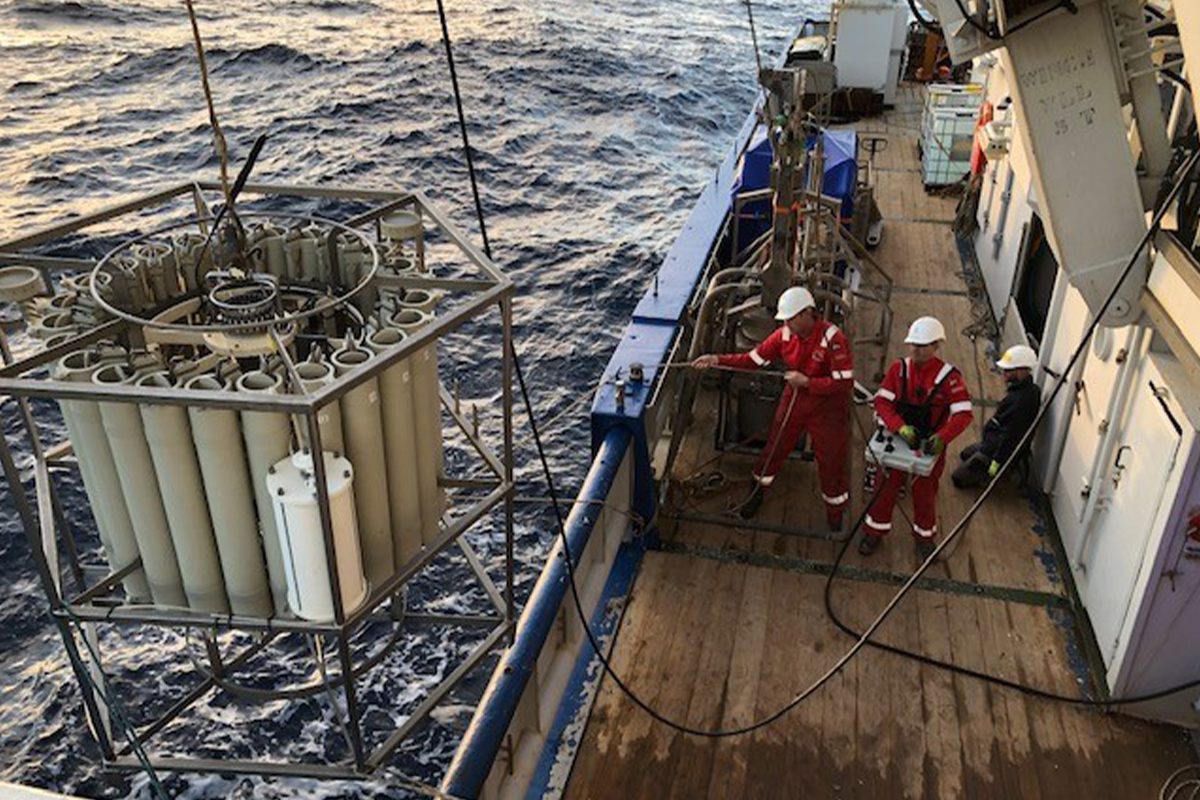
For me, it is the first time out on sea for more than just a few hours, and it has been an incredible educational experience already. Sample methods that I have learned about in classes, I now can truly experience in practice. Furthermore, apart from my own master research project, I also help out the other scientists wherever needed. Thereby I have acquired a new skill set ranging from injecting nutrients into incubation bottles to catching a drone on a moving platform. I also learned that you have to be creative with the tools and material at hand; out at sea, you cannot quickly run to the shop if you need something. We discovered, for example, that reusable cotton pads (normally used to remove make up), can also come in very handy for cleaning the lenses of the CTD sensors.
At some moments you are suddenly reminded that your temporary office is located in the middle of a beautiful, extensive ecological system. One of those moments was while I was looking out on the ocean, flushing one of my bottles, and suddenly spotted a fin between the waves. I went out on the deck and saw four dolphins! But afterwards, no one believed that I spotted dolphins this far off the coast. Luckily, that evening, it turned out that one of Thomas’s GoPro cameras had captured the dolphins, earning me the new nickname of ‘the dolphin spotter’.
BLOG 6 | 25 November 2020
By Thomas Mani
“It is not down on any map; true places never are.” Herman Melville, Moby Dick
While I witness many wonderful places during this expedition, it makes no sense to pin them on a map. For they can never be found the same again. As the water colour changes through countless hues of pearl blue to battleship grey, different shapes and sizes of waves and clouds, the moving sun, wind, and rain create infinite combinations of landscapes to admire every day. Despite this beauty, life on board comes with a price when, for example, I can hardly manage to stay seated at my lab bench during stormy weather and my stomach starts reminiscing about the steady floor back on land. Then again nothing beats waking up to a cup of coffee, a bowl of hot porridge and a fried egg on toast to be followed by a solid session of surface water trawling during a crisp and breath-taking sunrise. For all the breakfasts, lunches, and dinners– applause to Hassan and Vitali who prepare and serve food at the highest standards here on Pelagia.
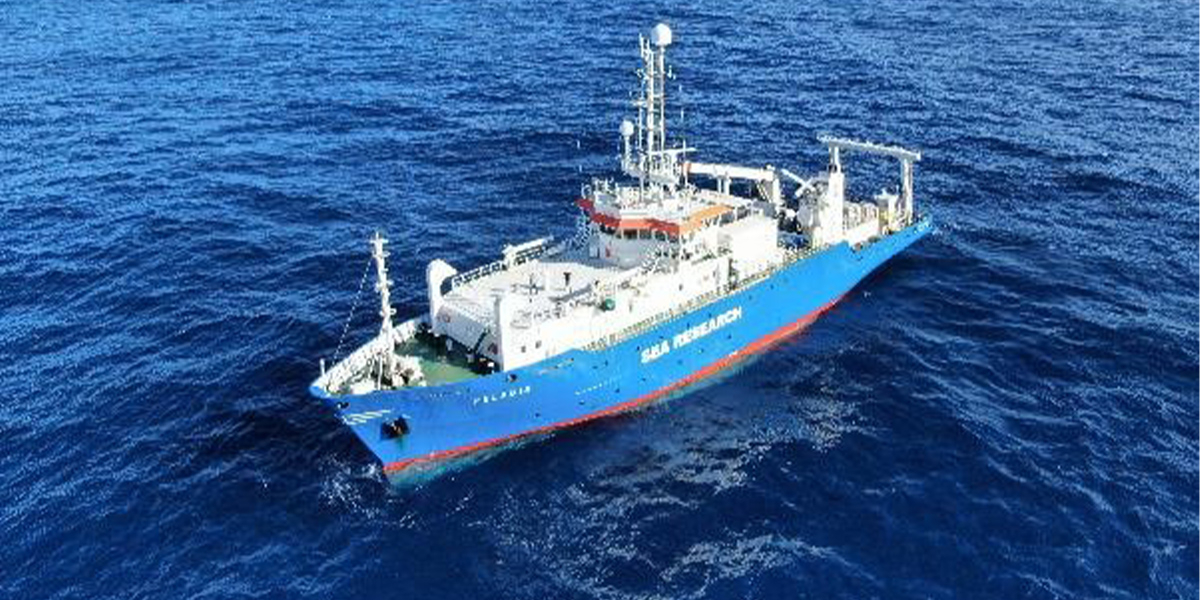
My name is Thomas Mani, and I am a research scientist at The Ocean Cleanup. On this expedition I target floating and submerged plastic particles using specialised nets (a so-called Manta Trawl and a Multinet). While such nets are a great tool to quantify smaller plastic fragments, they systematically underestimate concentrations of larger plastic objects. To have a more accurate estimate of the total mass of plastic accumulating at the ocean surface, it is essential to account for larger plastics as well. This is why we are developing a camera-based system that can identify larger plastic objects afloat at sea. We are currently comparing different types of cameras to assess the required optical quality for such instruments. Equipped with a drone, an automated debris identification system (ADIS II) and two GoPro cameras, I plan to return to land with approximately 800,000 images from the water surface for evaluation. While setting up camera systems on deck is relatively straight forward, launching the drone from a vessel is slightly trickier. As the ship is pitching and rolling in the swell there is no stable ground to take off and land, thus requiring a brave and well protected Sophie to catch the aircraft out of the air after flight missions.
Video 1: Sophie bravely and elegantly catching the drone on deck from mid-air
Another important, yet still largely unquantified, aspect in the quest to close the ocean plastic mass balance relates to the presence of plastics in the ocean water column below the surface. To date, there is only very limited observational data available on the vertical distribution of plastics at sea. This cruise provides me with the unique opportunity to study the extent to which plastics are present in the water column of the North Atlantic Ocean. I am particularly interested to find out whether floating microplastics are lost to the underlying deep sea. Previous research in the North Pacific Ocean has shown that floating plastic debris trapped in subtropical oceanic gyres slowly breaks down into microplastics that sink down into the deep sea. However, the magnitude of this plastic fallout and the underlying processes that result in the sinking of once buoyant microplastics remain largely unknown. To this end, I am collecting samples from the ocean surface using a Manta Trawl and combining them with samples collected from the water column below using a multinet system and a series of in-situ pumps. In total, I am aiming to sample over 20,000 cubic meters of seawater during the entire expedition. Ultimately, the data generated from this cruise will bring us one step closer to unravelling the mystery of the ‘missing ocean plastic’ and to assess the long-term fate of positively buoyant plastic debris at sea.
Video 2: It does not get much better than Manta Trawling at sunrise.
After long rewarding days of science, I enjoy having a cup of tea on the bridge with the captain or the first officer, getting a private guided tour through the mighty engine room with the chief engineer or sneaking in a quick game of darts with the chief scientist and the chief engineer. Secretly, I am hoping to improve my aiming skills on a moving vessel to return to winning ways when back on steady land.
BLOG 7 | 26 November 2020
By Emna Zeghal
We are reaching the final days of our expedition and are now in French territory near Brittany’s coasts. The sky is definitely getting grayer and the air colder. At times, I surprise myself whishing to go back to the first week when we were steaming along the sunny and warm 30°N latitude. But, as I have been reminded recently, one cannot stay forever at sea.
I am Emna Zeghal, a PhD student at NIOZ. I work on the degradation of plastics by marine microbial communities. Getting samples from the north Atlantic Gyre where plastic debris are known to accumulate is an amazing opportunity considering my research topic. My goals for this expedition are: to identify the microbial communities living on the plastic particles we are collecting with the manta trawl, grow and isolate fungal strains present on plastic debris. I am also setting up incubation experiments to determine how microbial communities from different locations and different depths would react to the presence of nanoplastics in.
Emna explains how she gets samples from the north Atlantic Ocean.
When I told my friends and family that I will be joining another research cruise in November, most of them thought I was crazy considering how seasick I was last time. Maybe I am a little bit. But I was just incapable of rejecting a once in lifetime experience like this one. At the end after a few first difficult days, this expedition might actually reconciliate me with my seafarer side :).
This expedition has been quite special from the beginning. Due to the corona regulations, the science party had to be reduced to 6 people. Which resulted in a little group of “plastic” researchers working with complementary approaches. And I learned a lot from everyone. Life on the boat for the 2 first weeks was also quite special. Trying to work fast and efficiently while respecting social distancing rules was challenging at times, but we adapted. Even when days get long and tiring, there is always someone to offer help or crack a joke to lighten the mood and lift spirits. We also had very nice times like whale and Dolphin watching thanks to Sophie our official “Dolphin spotter”. One of my favorite moments must be our first group dinner. After 2 weeks, we were finally allowed to lighten the social distancing rules and eat all together instead of eating in different shifts. So, Hassan and Vitali, our amazing galley duo, prepared a typical Dutch “gourmetten” feast to celebrate that. I know it’s not the end yet, but I want to thank everyone who was onboard RV Pelagia during this cruise (Bert, Martin, Kelly, Norberto, Chiel, Jacco, Martin, Mike, Martin, Inno, Hassan, Vitali, Erik, Thomas, Livie, Sophie and Helge). A special thank you to Sophie and Livie for the late night sampling/singing sessions (Sorry Erik for the quality of the performance).
As I said it is not the end yet, still 3 stations to go. You never know which surprises we can encounter!
